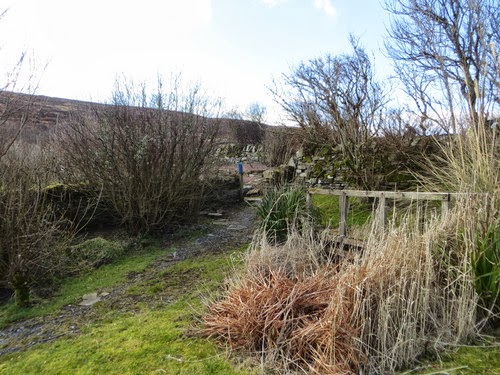Dont read ( or look) on if you are of a sensitive disposition .
The labels to this post are are "ducks" and "otter" .
Have a guess what has happened if 'duck' and 'otter' are in the same post.
You have been warned

So we went to lock the ducks up and there were only four of them. The one that was missing was one that had a bit of a limp for a couple of days . After a quick look round the adjacent land there was no sign of the limping duck.
And on closer inspection there were quite a few feathers scattered around the grass - certainly more than is usual
So I thought I'd better have a look along the burn. There were feathers in the water and stuck to the vegetation along the burn.
And a bit further up the stream we found the (inevitably, by now ) ex -duck .
Dont read (or look) on if you are of a sensitive disposition .
( more detailed pictures on request if you are interested in which parts of the duck the otter took )
According to 'tweb they normally hunt at night. This one - if in fact it is an otter that is doing this , but no-one has come up with an alternative suggestion- is hunting through the day , so its either very hungry, or very confident.
I need to find out about otters and their hunting habits. We can put wire mesh grids in the watercourses that run into the pond, but there is no point doing that if the animals are prepared to go onto the land to go round any obstacle.
We wonder if the limping was caused by an attempt from the otter a couple of days ago . And this one was the slowest out of the water or away from the pond when it came back to finish off the job.
Or we can fence the land either side of the stream they are hunting in . But how far out from the burn do we need to fence ?
The side of the burn are overgrown, so is there any point in cutting back the vegetation for a distance away from the pond ?
Is it worth it at all or do i just need to sort out one of the other ponds we have and move the ducks. It would be a shame because this pond has lots of fresh , running water.
So we will fence it off a bit, and not get any more ducks pending more information.








 But ducks will need water. We think the pond just fills from run-off from up the hill a little. Ducks like water and ideally some that flows. We certainly have a lot of water at the moment. There is a rivulet of water that runs down part of the garden so the great plan is to divert it into the pond and aid the flow of water into the pond.
But ducks will need water. We think the pond just fills from run-off from up the hill a little. Ducks like water and ideally some that flows. We certainly have a lot of water at the moment. There is a rivulet of water that runs down part of the garden so the great plan is to divert it into the pond and aid the flow of water into the pond. And over the afternoon the pond filled up a bit more .
And over the afternoon the pond filled up a bit more . And it flows over the low point of the pond , on its way to the Bay of Isbister via a burn or 2 . And round the pond is field. and excess water on the field makes mud .
And it flows over the low point of the pond , on its way to the Bay of Isbister via a burn or 2 . And round the pond is field. and excess water on the field makes mud .

